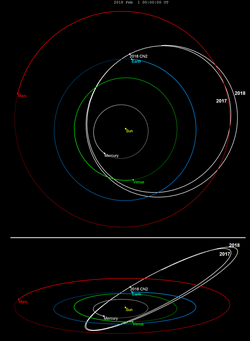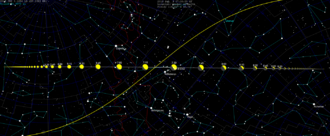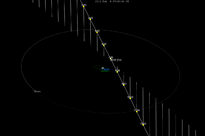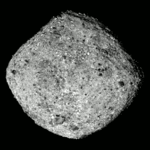Astronomy:2018 CN2
 The orbit before and after flyby, with positions on 1 February 2018, before flyby | |
| Discovery[1] | |
|---|---|
| Discovered by | Mount Lemmon Srvy. |
| Discovery site | Mount Lemon Obs. |
| Discovery date | 8 February 2018 (first observed only) |
| Designations | |
| 2018 CN2 | |
| Minor planet category | NEO · Apollo[1][2] Earth- and Mars crosser |
| Orbital characteristics[2] | |
| Epoch 23 March 2018 (JD 2458200.5) | |
| Uncertainty parameter 7 | |
| Observation arc | 1 day |
| |{{{apsis}}}|helion}} | 1.7740 AU |
| |{{{apsis}}}|helion}} | 0.6335 AU |
| 1.2037 AU | |
| Eccentricity | 0.4738 |
| Orbital period | 1.32 yr (482 days) |
| Mean anomaly | 348.58° |
| Mean motion | 0° 44m 46.68s / day |
| Inclination | 25.741° |
| Longitude of ascending node | 320.21° |
| 276.55° | |
| Earth MOID | 7.7×10−5 AU (0.03 LD) |
| Physical characteristics | |
| Mean diameter | 5–16 m[3] 9 m (est. at 0.20)[4] 17 m (est. at 0.057)[4] |
| Absolute magnitude (H) | 27.653[2] |
2018 CN2 is a very small asteroid, classified as a near-Earth object of the Apollo group, approximately 5 to 16 meters in diameter. It was first observed by astronomers of the Mount Lemmon Survey at Mount Lemmon Observatory, Arizona, on 8 February 2018, one day prior its close encounter with Earth at 0.18 lunar distances.[1]
Orbit and classification
2018 CN2 is a member of the Apollo asteroids, which cross the orbit of Earth. Apollo's are the largest group of near-Earth objects with nearly 10 thousand known objects.
Based on a high orbital uncertainty, this asteroid orbits the Sun at a distance of 0.63–1.77 AU once every 16 months (482 days; semi-major axis of 1.20 AU). Its orbit has an eccentricity of 0.47 and an inclination of 26° with respect to the ecliptic.[2] With an aphelion of 1.77 AU, it is also a Mars-crosser, as it crosses the orbit of the Red Planet at 1.666 AU. The body's observation arc begins at Mount Lemmon with its first observation on 8 February 2018.[1]
Close encounters
The object has an exceptionally low minimum orbital intersection distance with Earth of 11,500 km (0.000077 AU), or 0.03 lunar distances (LD).[2]
2018 flyby
On 9 February 2018, 2018 CN2 passed at a nominal distance of only 69,900 km; 43,400 mi (0.000466964 AU) from Earth at 7:25 UTC.[2] This corresponds to 0.18 LD. Based on the body's high orbital uncertainty, all subsequent close encounters in 2022, 2023, 2026, 2027 and 2031, are projected to occur at a distance of more than 15 million kilometers (0.1 AU; 39 LD).[2]
Physical characteristics
The Minor Planet Center estimates a diameter of 5–16 meters.[3] Based on a generic magnitude-to-diameter conversion, 2018 CN2 measures between 9 and 17 meters in diameter, for an absolute magnitude of 27.653, and an assumed albedo between 0.057 and 0.20, which represent typical values for carbonaceous and stony asteroids, respectively.[4]
As of 2018, no rotational lightcurve of 2018 CN2 has been obtained from photometric observations. The body's rotation period, pole and shape remain unknown.[2]
Numbering and naming
This minor planet has neither been numbered nor named.[1]
See also
- List of asteroid close approaches to Earth in 2018
References
- ↑ 1.0 1.1 1.2 1.3 1.4 "2018 CN2". Minor Planet Center. https://www.minorplanetcenter.net/db_search/show_object?object_id=2018+CN2. Retrieved 15 February 2018.
- ↑ 2.0 2.1 2.2 2.3 2.4 2.5 2.6 2.7 "JPL Small-Body Database Browser: (2018 CN2)". Jet Propulsion Laboratory. https://ssd.jpl.nasa.gov/sbdb.cgi?sstr=3799286;cad=1. Retrieved 15 February 2018.
- ↑ 3.0 3.1 Minor Planet Center. "2018 CN2". Twitter. https://twitter.com/MinorPlanetCtr/status/962463278684307462. Retrieved 10 February 2018.
- ↑ 4.0 4.1 4.2 "Asteroid Size Estimator". CNEOS NASA/JPL. https://cneos.jpl.nasa.gov/tools/ast_size_est.html. Retrieved 15 February 2018.
External links
- MPEC MPEC 2018-C76 : 2018 CN2, Minor Planet Electronic Circular, 10 February 2018
- Asteroid 2018 CN2 close approach, International Asteroid Warning Network (IWAN)
- Asteroid 2018 CN2 flew past Earth at 0.18 LD, discovered one day before closest approach, The Watchers, 11 February 2018
- 2018 CN2 at NeoDyS-2, Near Earth Objects—Dynamic Site
- Ephemeris · Obs prediction · Orbital info · MOID · Proper elements · Obs info · Close · Physical info · NEOCC
- 2018 CN2 at the JPL Small-Body Database
 |





